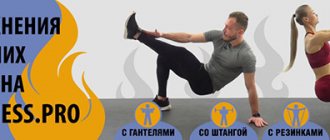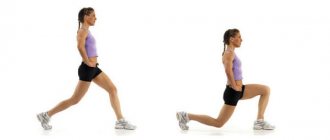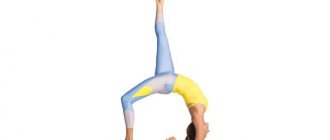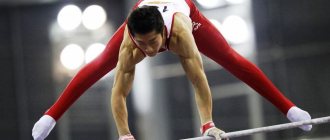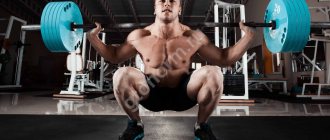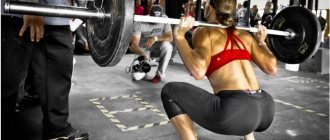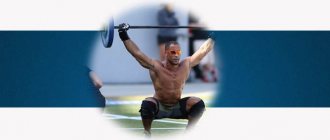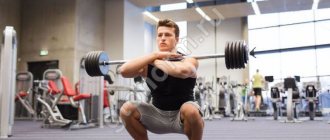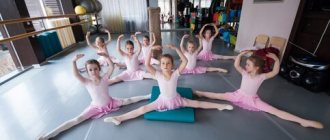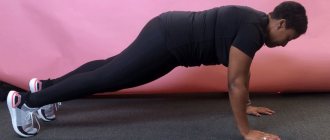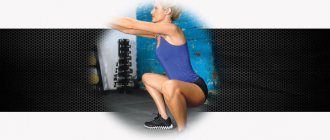Single-leg squats are an effective leg muscle development exercise that also strengthens the abs, develops balance, and improves agility and strength. Surely you remember these squats from school - all boys pass the pistol standard from about 8th grade. But for adults, it is much more difficult to master the exercise - both the body weight is greater and the muscles are not as prepared.
However, this exercise is considered extremely productive, which is why many athletes are interested in how to learn to pistol squat on one leg at home or in the gym, with the help of auxiliary equipment.
What is the exercise
Its name speaks for itself - it is a squat on one limb, while the other is held suspended in front of you. It can be performed in any room or even during street training. It wonderfully develops the quadriceps femoris muscle, as well as the gluteus maximus. Due to the shifting of the center of gravity in the process, it trains the sense of coordination and balance. If you squat without additional weight, you place virtually no stress on your spine. By the way, in order to keep your non-working leg suspended, you will need strong abs, which means that at the same time you are working on the treasured abs on your stomach along with your hips.
Do you want to know how to properly squat on one leg with a pistol squat? If so, read on.
Lead-up exercises
Only a few athletes can immediately perform a squat on one leg without support. The vast majority of people, even if they can sit down, will certainly not be able to stand up. And the point is not always the weakness of your muscles, but mostly the unfamiliarity of the load.
So, what exercises can you do to prepare your muscles for performing pistols:
- Stand with your feet shoulder-width apart. Raise your straight leg until it is parallel to the floor and try to stand in this position for at least 30 seconds. This is not the easiest task.
- Next, practice squatting on one leg without raising the other in front of you. To do this, you will need a sturdy stand or box. Place the box near a wall or other support. Holding the support with your hands, squat on one leg, freely lowering the other down.
- The next step is to perform pistols while holding the support with your hands. That is, we squat on one leg, bringing the other forward, but at the same time supporting ourselves with one or two hands. In particular, you can perform the exercise by opening the door and holding its handles on both sides with your hands. When squatting, the door is located between the legs. The main thing is that the door fastening is strong enough.
- Make it more difficult. Now you squat without holding it with your hands, but simply touching the support with your shoulder. Stretch your arms forward. The benefit of such touching the support is rather psychological. In fact, this is already a full squat on one leg.
In addition to the above exercises, classic squats with a barbell, dumbbells or other weight will help you gain overall leg strength. You can perform single-leg squats on a Smith machine. In this case, there is no need to maintain balance, which simplifies the task.
Be sure to include some leg stretching exercises in your workout plan. Without sufficient flexibility, it will not be possible to perform the exercise correctly.
With strict adherence to these recommendations and regular training, you will receive well-developed leg muscles and toned buttocks as a reward for your efforts. The main thing is to remember about the impact on your knees, and if the slightest discomfort occurs, reduce the load.
The exercise is not for beginners. Women also do it extremely rarely.
The benefit of squats on one leg is that the following muscles are loaded:
- gluteus maximus,
- quadriceps femur (front surface),
- adductor femoris (inner surface),
- biceps femur (posterior surface).
A good sense of balance and coordination is required. Especially advanced athletes squat on one leg with weights - dumbbells or kettlebells.
Execution technique
To get started, check out our tips that will help you master the technique faster:
- Do a good warm-up, thoroughly warm up your muscles, ligaments and joints. To prepare for this particular exercise, perform classic squats, running in place, jumping;
- The squat is performed smoothly, without jerking or acceleration on the descent or ascent;
- If you can’t maintain your balance at first, stand at a support. But remember, it only helps maintain balance, and is not a lever or tool to make the task easier. If you're still tempted to lean on a handrail or wall while lifting, try doing one-legged back squats;
- You will need to constantly monitor your free limb to ensure it does not touch the floor. To make this part of the exercise easier, try squatting from an elevated position, such as a gymnastics bench.
- Stand up straight, transfer your body weight to your working leg, lift the other one off the floor, slightly bending it at the knee;
- Tighten your abs, stretch your arms forward and make sure you have your balance;
- Tilt your pelvis slightly back, and the upper part of your body, on the contrary, forward, and, while inhaling, begin to slowly lower;
- Gradually straighten the free leg, at the lowest point it should be in a position parallel to the floor, without touching it;
- As you exhale, begin to rise, pressing as much as possible on your heel - slowly straighten your knee, pushing your body up;
- Do the required number of repetitions and change legs.
Common execution errors
The technique of performing a squat on one leg is not complicated, but still many athletes often make serious mistakes. Meanwhile, this is fraught with serious injuries or sprains. What errors are most common?
- During all stages, you cannot lift your heel off the floor - this can lead to loss of balance and stimulates a greater load on the ankle;
- At the top point, the knee of the working support is not fully straightened;
- The knee should always point in the same direction as the toe. Do not tilt it to the right or left, so as not to increase the load on the joints.
- You need to keep your back straight, avoiding arching, especially if you squat with weight.
How to learn to pistol squat: introduction exercises
Not many people can master the pistol squat technique; you need to start with introductory exercises that will make it easier to get used to the load.
Almost everyone can sit down in this position, but only a few manage to stand up, and the reason does not lie in muscle strength. The secret of success is in mastering the preparatory exercises:
- The exercise begins by raising your leg so that it is parallel to the ground. Stay in this position for 20–40 seconds, then change limbs.
- The squat is performed strictly on one leg. The second hangs in a free position. The task is performed with a support, which is held with both hands.
- You can move on to the stage of performing the exercise. It is performed using a fulcrum, for example, an ordinary door. Holding the handles of an open door, you should position yourself so that when you squat, the door is between your legs.
- The final stage is performed without any support, only the shoulder touching the support is allowed. Stand, for example, near a wall, turning your side towards it, then start doing a squat. If you feel off balance, lean against a wall and keep moving.
Please note that the wall has more of a psychological meaning, it does not provide real physical help.
In addition to the listed methods, the usual squats with a barbell and dumbbells can increase the strength of the limbs. Did you know? The most expensive and popular gym in the world is located in Thailand, it specializes in martial arts. A full membership with all available services costs approximately $3,444 per year.
What muscles work?
Let's find out which muscles work when doing pistol squats on one leg - we'll identify both the primary and secondary muscles.
Target muscles are the gluteus maximus and quadriceps femoris. They are the ones who experience the most stress. At the same time, the abs, the extensor spinae, the posterior thigh muscle, and the calf muscles work.
Thus, the strongest effect from squats on 1 leg is received by the butt and hips. Do you want to have a pumped up butt and muscular legs? Then learn to squat on one leg!
Advantages and disadvantages
Let's look at the advantages and disadvantages of this exercise.
Positive traits:
- develops coordination, flexibility and well activates neuromuscular connections;
- develops control over your body;
- all fibers of the quadriceps muscles take part in the work;
- a lightly loaded back will avoid unwanted problems with the spine;
- You can do squats on one leg everywhere; there is no need to purchase special equipment.
The disadvantages include the following:
- it will be quite difficult for beginner athletes due to the lack of flexibility and muscle strength, therefore the risk of injury increases;
- The knee joint is heavily loaded and can be damaged if squats are performed incorrectly.
Overall, the pistol squat is a positive exercise, and with sufficient physical fitness it will be quite appropriate in any training program.
Did you know?
The record for squats with a 100-kilogram barbell belongs to Sergei Rachinsky. In 25 minutes he squatted 212 times.
What exercises will help you learn to squat correctly?
- A distant “relative” of pistol squats are Bulgarian lunges - they are also performed with one non-working leg. The latter is pulled back and placed with its toe on a hill. Exercise helps you learn to maintain balance and strengthens your leg muscles;
- Be sure to master the correct technique of classic squats - in this case, you will intuitively breathe correctly, keep your back straight, and strengthen your muscles;
- Train your abs - otherwise you will hardly be able to perform many repetitions in one approach.
Execution options
Now, let’s find out how to properly do a pistol squat on one leg in different ways.
- The classic version is squats without support with arms outstretched in front of you;
- With support from the side or behind - help maintain balance;
- You can practice in a Smith machine while holding the bar. At home, a regular chair with a back will do;
- When the technique is mastered to perfection and your own weight becomes insufficient for a suitable load, take dumbbells;
- The most difficult option is one-leg squats with a barbell. Squats on one leg with weight involve a considerable load on the spine, therefore, in this case, you must take into account that the list of contraindications increases greatly;
Only athletes with a good level of training should squat with a barbell or dumbbells - they must have perfect coordination and be able to withstand the load.
Learning to squat on one leg
Even if you already know how to squat well, you won’t be able to do it on one leg without preparation. To learn how to pistol squat, you need to train by performing lead-up exercises.
Narrow leg squats
Ideally, both legs should be side by side - this type of squat will allow the quadriceps to get used to the load. You can do this exercise well in a Smith machine, where you don't risk losing your balance.
Technique:
- It is necessary to place the barbell on the shoulder girdle and the top of the trapezius muscles, placing your legs as close to each other as possible.
- In the Smith machine, the feet can be moved quite far forward. This is just useful for preparing for single leg squats.
- While inhaling, with a straight back, we squat as low as possible without bringing our knees beyond the line of our toes.
- As you exhale, we return to the starting position.
If you have any lower back problems, you can try the following narrow leg squat variations to strengthen your lower body muscles:
Wall Squats
The partner in this case acts as a counterweight, keeping you from falling backwards.
Supported pistol squats
After or at the same time that you have mastered the technique of squatting with narrow legs, we begin to try the “pistol” with different belay options.
Do back squats
The simplest option is to squat on one leg on a bench, sofa, chair or other support, which should be gradually lowered.
Technique:
- We choose a support on which we will sit.
- To maintain balance, your arms can be extended forward or spread to the sides.
- One leg should be straightened and raised in the air.
- The second one needs to be bent and sit on a support.
This needs to be done slowly and in a controlled manner, but chances are that at first you will simply fall onto the bench. This is fine. Gradually the muscles will become stronger and you will be able to perform the exercise correctly.
"Pistol" with support
The support can be used in other ways.
You don’t have to sit on it, but hold onto, for example, a door handle, TRX hinges, a chair or a partner’s hand.
This option is best mastered after you begin to be able to squat on a support more or less under control, since this exercise is more difficult.
Technique:
- We firmly grasp the support with one hand or two.
- Inhaling, we begin to slowly lower ourselves down.
- As we exhale, we stand up.
Please note that the lower you sit, the more you will pull on the support, so you need to make sure that the support is secure, otherwise you will fall back along with the person or chair. At first, you may not squat very low, but gradually you should try to touch the calf muscle of the thigh
At first, you may not squat very low, but gradually you should try to touch the calf muscle to the thigh.
"Pistol" supported on the wall
Just like narrow leg squats, start doing wall squats, trying not to hold onto anything else.
At first, you can squat shallowly - until your thighs are parallel to the floor or slightly higher. Gradually you need to drop below parallel.
You can perform this exercise dynamically, or using statics and lingering at the lowest point.
Pistol squats - lightweight options
Once you have started to get comfortable with squats with support and support, you can start doing pistol squats, but using some tricks.
Squats on a bench
In this case, you are already squatting without support, but also in a somewhat lighter version.
Technique:
- We stand on a bench or other support so that the supporting leg stands securely and firmly on the surface, and the second leg can fall below the level of the support.
- For balance, we hold our hands in front of us, sit down, without extending our free leg, but lowering it down. This will help you maintain your balance.
- As we exhale, we stand up.
Counterweight squats
This is perhaps the rare case where extra weight can help, acting as a counterweight and preventing you from falling.
You can use a kettlebell, dumbbell, medicine ball, or other type of weight. You can hold it at arm's length or near you.
As in the previous versions, at first you can not squat all the way, gradually lowering yourself lower.
Benefits, harms and contraindications
Now we will look at the benefits or harms of pistol squats on one leg, and also list a list of contraindications.
They have only one drawback - they are too complex to be easily completed by a beginner. But there are many more advantages:
- The exercise does not require a gym;
- It perfectly pumps the butt and thighs without loading the back (if without weight);
- Trains the sense of balance;
- Helps add variety to monotonous strength training sessions.
Contraindications:
- It is prohibited for people who have any problems with the knee joints to perform squats on one leg. So be careful and listen to your body at the first sign of knee pain after running;
- If stress on your back is contraindicated for you, it is not recommended to squat with weight;
- You cannot exercise during exacerbations of chronic diseases, at fever, after abdominal surgery;
- People with heavy weights should not perform such squats;
- If you have chronic diseases, we recommend that you first consult with your doctor to make sure that exercise is not prohibited for you.
Well, we found out the pros and cons of squats on one leg, we know how to perform them correctly and what variations of the exercise exist. So who is it suitable for?
Who is the exercise suitable for?
- Girls who want to improve the shape and contours of their figure, lose excess weight in the buttocks and thighs (in the case of squats without a dumbbell or barbell);
- Athletes whose goal is to build muscle mass (in the case of squats with dumbbells or any other weight);
- Athletes who do not have the opportunity to squat with heavy weights due to health reasons, but want a beautiful relief.
If you want to know what single leg squats can do for 1 minute a day, just try doing it every day for a month. The result will definitely surprise you! An approximate program for single-leg squats for beginners is as follows:
- First, do 5 repetitions on each leg;
- Gradually raise the bar up to 15 times;
- Increase the number of approaches;
- A good indicator is 3 sets of 15 times;
So, we have discussed the pistol squat technique, now you know all the theoretical subtleties and nuances. The time has come to start practicing - remember, always begin to act carefully, listen to your own feelings and stop if any painful sensations arise. I wish you success in sports and personal victories!
